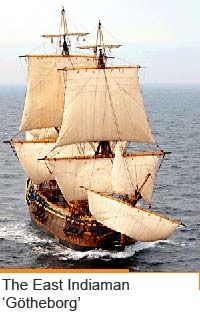
The air reeks of tar, turpentine and linseed oil. Eighty people are working away frantically on deck. You can almost envisage what life at sea must have been like in the 18th century on board the East Indiaman whose replica so accurately reflects the golden age of sailing. Mind you, the new vessel hides a secret or two, which may explain the difference between being an 'exact' replica and a 'perfect' replica. For example, the entire lower deck of the replica is crammed with state-of-the-art machinery and technology.
We called on this graceful vessel just a few weeks before she was scheduled for her maiden test voyage. As is the case on most construction sites just prior to delivery, the vessel was a showcase of goal-oriented chaos. People were working high and low. Equipment and materials were all over the place. Chief Engineer Sture Arvidsson was nonetheless calm and optimistic, assuring us that the vessel will be accorded the respect and pride she deserves when she sets out on her great voyage to China.
The ship has a fascinating history. In the 18th century, Sweden's commercial and maritime activities were heavily reliant on the Asian trade. Long voyages on the high seas were a risky business, with lives and formidable treasures at the mercy of the whims of Mother Nature. Indeed, the original vessel met her destiny when she foundered on a rock and sank to the bottom of the sea in the very entrance to her home port of Gothenburg, Sweden. The vessel's tragic fate was forgotten for a long, long time, until a diver rediscovered the wreck in 1984.
"Someone came up with the crazy notion of building a full-scale replica of the vessel, but I don't think they had any idea what they were in for!" laughs Arvidsson in retrospect. However, those first enthusiasts must have been convincing, because they had no trouble finding sponsors and partners. Roughly 350 million Swedish Crowns were collected, and sponsors and partners have donated equipment and specialist work worth who knows how much. The idea was to reconstruct the ship and make her into a proud symbol of Sweden's international trade, industry and culture.
The propulsion system – a challenge (to put it mildly!)
"The greatest challenge we've faced has been to find technical solutions that meet the current requirements of the international maritime authorities, while retaining the classic historical appearance of the East Indiaman", Arvidsson points out.

"Naturally, the vessel also has to meet today's standards for health, safety and the environment, areas where the world has, in fact, made a wee bit of progress since the original vessel was sailing. Today's requirements and standards have been quite difficult to combine with the desire to retain the vessel's carvel construction, but we have generally managed to find solutions that satisfy all parties. In consequence, however, most of the vessel's technical equipment has been placed deep down in the vessel, along with a full-scale, modern engine room. While the vessel is an exact replica of the original on the outside, her 'innards' contain the very latest technology.
"The vessel is equipped with five waterproof bulkheads. They are intended to optimise safety at sea, but presented challenges in terms of where cables and pipes were to be placed", smiles Arvidsson. "Despite the vessel's space constraints, she is now equipped with systems comparable to those on major merchant vessels."
Arvidsson discloses that the engine alone has required 80 000 hours of work by the shipyard personnel. He has no idea how much time the various equipment suppliers have invested.
The three main engines have an output of 100 HP at 'all ahead full', and top speed is eight knots. Power is supplied by two main generators, and the vessel carries a fairly heavy-duty emergency back-up generator. To ensure safety on board, there is a double fire and bilge pump, as well as a fully automatic sprinkler system that remains functional even if the ship's power supply fails.
The vessel's engine room is designed to be unmanned for long periods of time. The surveillance and alarm functions are located in the navigation bay, allowing the duty engineer to monitor all relevant readings from there.
"The team that has worked together to accomplish all this has been absolutely amazing", continues Arvidsson. "Specialists, boat buffs and idealistically-inclined pensioners have worked side by side. The quality of their craftsmanship is exceptional. Being allowed to help re-create this vessel is a dream come true for many of them, like winning the jackpot in some huge lottery. I believe I speak for many people, when I say that it will be a thrill to see the vessel set sail, and know that I helped it happen", concludes Arvidsson, who is busy putting the final touches on the replica of Sweden's proud vintage flagship.
KONGSBERG – official sponsor of the Swedish East Indiaman
 Building one of the world's largest wooden sailing ships in modern time calls for tremendous resources in terms of materials, funding and personnel. This project could never have been undertaken, let alone completed, without generous support from 'outsiders'. This help included materials for the ship, support from local, regional and national authorities, and financial support. KONGSBERG has provided a DataChief C20 alarm monitoring and control system equipped with operator stations both in the engine room and the navigation bay.
Building one of the world's largest wooden sailing ships in modern time calls for tremendous resources in terms of materials, funding and personnel. This project could never have been undertaken, let alone completed, without generous support from 'outsiders'. This help included materials for the ship, support from local, regional and national authorities, and financial support. KONGSBERG has provided a DataChief C20 alarm monitoring and control system equipped with operator stations both in the engine room and the navigation bay.
Facts about
The Götheborg is a replica of a vessel owned and operated by the Swedish East India Company, founded in Gothenburg in 1731. In 1984 the Swedish Underwater Archaeology Society made its exciting rediscovery of the 18th century trading ship. The SOIC (Swedish East India Company) was founded in 1993 to make a replica of the foundered vessel. The Götheborg is being built with generally the same dimensions, alignments, hull and rigging as would have been used for a Swedish East Indiaman in the 18th century. The vessel is also approved by the Swedish maritime authorities for ocean-going ships. Ultimately, she will be a teaching ship with a crew of 80, comprising 30 officers and 50 pupils. The sheer size of the ship is impressive: She is some 50 metres long and 11 metres wide in the beam; she is 47 metres high and displaces 1250 metric tonnes of water. She has been built entirely on the basis of 18th century craftsmanship and using materials available at that time. She is 75 percent oak, while pine and elm account for the rest. Her maiden voyage is scheduled take her all the way to China take about two years.